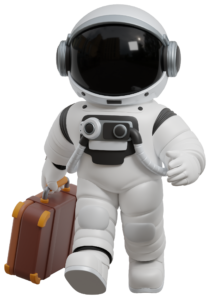A syllabus is a detailed document provided to students at the start of a course that outlines the learning plan for the course, including weekly topics, alignment to course learning outcomes, required readings, and assessment due dates. The syllabus provides students with a roadmap for the semester, helping them understand the scope and sequence of their learning, plan their time effectively, and know where to access resources and support. For faculty, the syllabus is a tool that ensures alignment between course design and delivery, offering transparency and consistency. Providing a syllabus at the beginning of the semester sets clear expectations, fosters accountability, and establishes a foundation for a productive and engaging learning experience.
EXAMPLE: Alien Technology 101
Here is an example of a completed syllabus for the fictional course, Alien Technology 101.
| Wk | Topic | Instructional Materials (Lessons) | Learning Activities (Ungraded Practice Activities) | Assessments (Graded) | Learning Outcomes | Learning Objectives |
|---|---|---|---|---|---|---|
| 1 | Course Introduction and Foundations | Read: Chapter 1 [textbook] Listen: Episode 4 [podcast] |
Class discussion on examples of alien technology in science fiction. | |||
| 2 | Theoretical Principles of Alien Technologies | Read: Chapter 2 [textbook] Watch: “Alien Technologies Used in Modern Day Film” [YouTube] |
Identify and analyze key alien technologies used in film. | |||
| 3 | Alien Propulsion Systems | Read: Chapter 5 [textbook] Watch: “Propulsion Systems: Past, Present, and Future” [YouTube] |
Discuss in Groups: Compare alien propulsion systems with current human-engineered technologies. | |||
| 4 | Energy Sources and Sustainability | Read: Chapter 9 [textbook] Listen: Episode 27 [podcast] |
Group research on alien energy concepts and presentation of findings. | Technology Analysis Report Due: September 30 Value: 20% |
CLO 1 | Obj 1.1, 1.2, 1.3 |
| 5 | Alien Materials and Their Properties | Read: Chapter 4 [textbook] | In Pairs: Research and document properties of alien materials. | |||
| 6 | Designing Alien-Inspired Devices | Read: Chapter 11 [textbook] | Begin designing blueprints for an alien-inspired device. | |||
| 7 | Prototyping and Simulation | Read: Chapter 3 [textbook] | Hands-on prototype building session. | Conceptual Design Project (Part 1) Due: Dec. 17 Value: 10% |
CLO 2 | Obj 2.1-2.3 |
| Study Week | ||||||
| 8 | Ethical Considerations in Alien Technology Adoption | Read: Chapter 6 [textbook] | Debate on ethical considerations in adopting alien technologies. | |||
| 9 | Societal Impacts of Alien Technologies | Read: Chapter 7 [textbook] | Group work to identify societal challenges and propose solutions. | Ethical Case Study Due: Nov. 3 Value: 20% |
VLO 3 | Obj 3.1-3.4 |
| 10 | Developing Responsible Guidelines | Read: Chapter 8 [textbook] | Draft responsible adoption guidelines in teams. | |||
| 11 | Interdisciplinary Applications of Alien Technologies | Read: Chapter 12 [textbook] | Brainstorm real-world applications for alien-inspired designs. | Role Playing Scenario Due: Nov. 20 Value: 20% |
VLO 3 | Obj 3.1-3.4 |
| 12 | Conceptual Design Project | Read: Chapter 10 [textbook] | Peer and instructor feedback on designs. | |||
| 13 | Test | Test Due Date: Dec. 13 Value: 15% |
CLO 1, 2, 3 | Obj 1.1-1.3, 2.1-2.3, 3.1-3.4 | ||
| 14 | Final Presentations | Class reflection on learning achievements and feedback for improvement. | Conceptual Design Project (Part 2) Due: Dec. 17 Value: 15% |
CLO 2 | Obj 2.1-2.3 | |
Note: 30% of the course’s total weight is evaluated prior to mid-term.
 ✐ Blueprint in Action
✐ Blueprint in Action
Navigating the Semester with a Stellar Flight Plan
Launch your course with clarity and structure using the Course Syllabus Sample (Template) to map out a seamless learning adventure!
